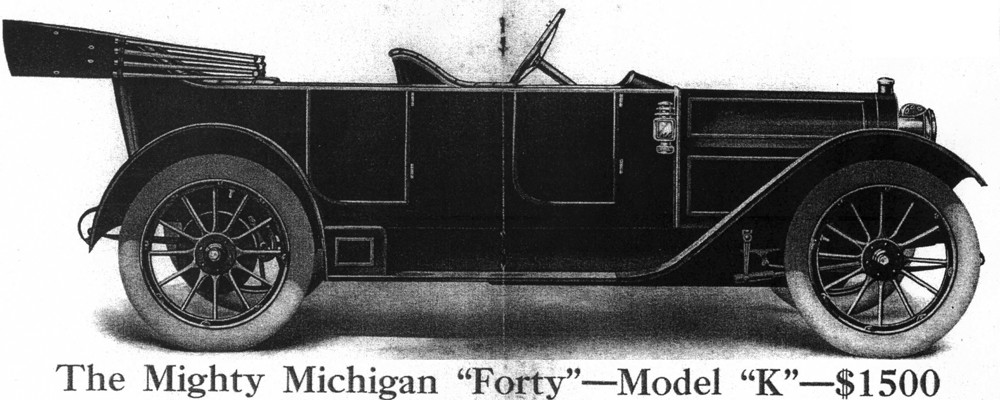One of the necessary parts for initial start up and running that is absent when you have removed the body of the car, is some place to sit. I found a back seat from a Ford Econoline van advertised on-line and picked it up. The floor mount brackets were missing, so I had to buy a set. You can see from the picture that if I sit in the middle of the seat, I get a seat belt. I hope I don’t need it.
Our GEMMER, Model “O” steering column comes with a quadrant situated in the center of the steering wheel. This mechanism controls the linkage for both advancing and retarding the spark at the distributor on the magneto and another lever for controlling the accelerator. The inner lever controls the spark advance and retard. The outer lever controls the accelerator. Both levers are in the top or near top position in the photo below, which is the most retarded position and the lowest accelerator (engine idle) position.
Getting our magneto installed and properly timed with the engine (a guess) was a bit of a project and took both research and some educated guessing. Carl Bloom had a new magneto adjusting connector disk built for us. (The one on the car as we got it was for a tapered shaft and our magneto has a straight armature shaft.) The disk and the matching “shaft connector” each have 20 holes around their circumference. Each hole represents 18 degrees of a circle and moving one of the disks one hole in either direction relative to the other disk (remaining stationary) changes the spark timing 18 degrees. See photos, below.

Water pump on the left. Shaft from pump to disk connector to magneto. Oil level sight gauge has blue tape.
It is unknown what the number of degrees of change can be achieved by moving the spark lever on the steering column. We may be able to determine this at some point in the future by using a timing light when the engine is running.
To determine an approximate “correct” spark timing necessary to run the engine, I needed to do several things. First, get all the magneto and ignition coils, spark plug wires, spark plugs and a new 6 volt battery installed. Next, to see if the timing marks that are on the fly wheel actually match up to engine positions. (Is TDC – Top Dead Center, really TDC?) and what the engine cylinder firing order was. BUDA Motors pamphlet number 176, indicates that the firing order is 1, 3, 4, and 2, starting with the cylinder closest to the radiator.
I installed a small 6 volt battery in an inconspicuous place on my temporary frame behind where the floor boards would fit. This lead acid battery replaces a completely corroded Ray-O-Vac dry cell lantern battery that came with the car.

Battery is on the left of the photo with our newly installed ignition switch & high tension coil (in a box on the firewall side) at the top center.
With the battery installed I needed to figure out which terminal on the magneto matched up with which cylinder in the proper firing order — 1, 3, 4, 2. so the easiest way to do this was to wire the magneto up, pull out the number 1 cylinder spark plug and lay it on top of the engine to see when it sparked. After a bit of trial and error, I developed the following map of the magneto rotation and firing order. See photo.
With this knowledge, I could now see if we had #1 spark plug firing when the fly wheel was coming up on Top Dead Center. The engine is intended to turn clockwise when viewed from the front of the car, so the direction of rotation of the fly wheel in the photo below is from the bottom towards the top of the photo. I did a lot of finger in the priming cup hole testing to see what cylinder was under compression as I manually rotated the flywheel. I verified that, yes, the notation “TOP DC- 1&4” corresponded correctly with what I was feeling going on inside the engine. It was a lot of slurping and puffing through the priming cups but, it was nice to confirm that valves and pistons seemed to be doing their jobs at the right times.
By the way, priming cups are little brass cups with lever valves below them that screw into little holes in the cylinder head. One priming cup for each cylinder. With the valve closed, a teaspoon of gasoline goes in each cup then the valve is opened to let the gas into the combustion chamber (cylinder). Then the valve is closed so no pressure can escape. Then you theoretically try to start the car. If you leave the valve(s) open, no vacuum or pressure can develop in the cylinder because it is venting to the outside air. But they are very useful in feeling suction and pressure as the engine is manually turned and they make a sucking wheezing sound while you do this turning. Priming cups were no longer installed on most car engines as electric starters and better carburetors were developed. I don’t think any were used after about 1920, other than maybe for tractors and some motorized farm equipment.






